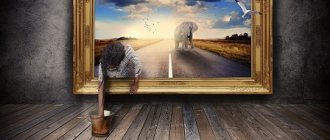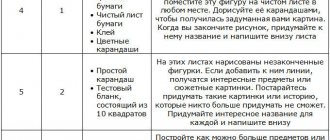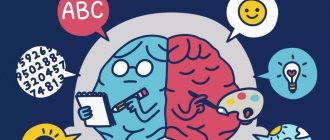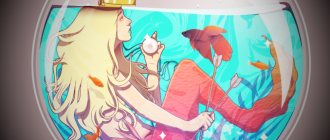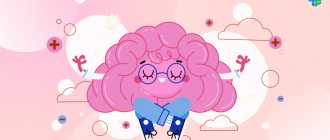Although many people think that only composers, writers, artists and some other representatives of certain creative professions need to develop creative thinking, this statement is not true! Why? The thing is that with the help of well-developed creative thinking, you can find optimal ways out of the most difficult and unusual life situations, successfully solve everyday everyday issues, see something new in things that have long been familiar, quickly and correctly respond to any problem, etc. .d.
Creative thinking needs to be developed not only by those people who are directly related to creative areas of life, but also by ordinary managers, clerks, accountants, schoolchildren and students, parents, etc. Why and why? Because a manager who knows how to think non-trivially and creatively will be able to sell more goods, an accountant will be able to find a way to save a significant amount of money for his company, a student will be able to find a well-paid and promising job, a parent will be able to teach his child to go beyond the generally accepted framework and create something new. .
What is creative thinking? Why does it need to be developed? What effective and efficient ways to develop creative potential are there? We bring to your attention the top 10 methods and exercises for the development of creative thinking, thanks to which you will learn to think creatively and be able to expand the boundaries of your worldview!
Why do you need to develop creative thinking?
The thinking of an adult is replete with patterns and stereotypes. They make life much easier when you need to act according to an already known scheme. Reactions and actions are practiced to the point of automaticity, so we spend much less effort and time on them.
The working day of the average person consists of familiar actions and manipulations. We come to the office, sit down in our own chair, look through email, and perform a number of routine tasks. And so on day after day. For all these actions, strong neural networks are formed in our brain.
But life doesn't always go according to plan. When a situation arises that does not fit into the usual pattern and requires qualitatively new actions, we fall into a stupor. It is incredibly difficult to move away from the usual stereotypes. It's like driving off a deep rut on a country road.
A person who is able to quickly rebuild and adapt to changing conditions turns out to be several times more effective. Therefore, it is necessary to develop creative thinking. It makes the mind more flexible, plastic, and variable. And it allows you to successfully solve not only familiar routine tasks, but also qualitatively new ones.
Developed creative thinking is an integral characteristic of a person whose activity is related to creativity in one form or another. And these are not only artists, writers and musicians. Many modern fashionable professions fall under this category: marketer, PR manager, designer, copywriter, content manager and others. The world is changing and requires a person to be able to quickly adapt to these changes.
Take notes
“Creative people are note-taking experts,” writes Professor Guy Claxton. They have better developed visual thinking skills. In How to Find Ideas, Ingledew advises noticing, collecting, and using things that most people don't even see. It is active curiosity that can show that the world is, in fact, full of ideas.
Exercise: Have you noticed that shadows sometimes randomly form the outlines of letters or numbers? New forms can be seen by observing the play of light and shadow, the movement of the hands on a dial, or simply the weather. Spontaneous notes help reveal the essence of things.
Exercises
Developing creative thinking is a fun and easy process. The main obstacle you will face is your inner critic. Some exercises will seem stupid, pointless, stupid to you. Feel free to brush aside all these thoughts. Allow yourself, at least for the duration of your training, to be frivolous and fool around from the heart.
The tasks presented are suitable for adults and teenagers. Remember that they don't have the right solutions. Therefore, the question of whether I do everything this way should not bother you.
I accompanied some exercises with comments and shared my options for performing them. I encourage you to share too. There is a comment field at the bottom of the article. You can send the results of your creative activities there.
Associations
Pick up a book, open it to a random page and point your finger at any word without looking. Now come up with as many associations to it as possible. Start with the most obvious ones, and then try to get as far away from them as possible. At the end of the list you will have associations that only you understand. And that's okay.
I came across the word “notebook”. My associative row with him looks like this: words, sheets, paper, lines, white, diary, essay, numbers, mathematics, four, rustling, stain, crumbs, pocket, wound.
Paradoxical connections
Choose two words that are not related to each other. You can use the book again. Now try to come up with a sentence that uses both words logically.
I came across the words “monkey” and “win”. This is what I did with them: “I spent the whole evening trying to beat the monkey at chess, but I couldn’t.”
Instructions
Take any item and try to come up with as many ways to use it as possible. The more unusual and interesting they are, the better.
I took a toothbrush. She can:
- brush your teeth;
- clean shoes;
- paint;
- comb hair;
- apply a face mask;
- comb out cat hair;
- scratch your back, etc.
Once you have your list ready, come up with instructions for one of the uses. It might look something like this:
Take the toothbrush, place it in your right hand and clasp it tightly with all five fingers. Place your hand behind your back and begin to move up and down your back in the place where the itching is felt. Continue until the itching goes away. Perform multiple approaches if necessary.
Limited story
The essence of the exercise is that you need to come up with a story consisting of a certain number of words. You set this quantity in advance. For example, 100 words, 50 or 200. Try different options.
You cannot deviate even a word from the given quantity! The story should be coherent and logical. It must contain all the necessary elements of a story: beginning, climax and denouement.
New language
As a child, I loved inventing new letters and words. As it turns out, this is a great exercise in creativity. Try creating your own language. Start by writing the alphabet, then move on to words and sentences.
John Tolkien, author of the Lord of the Rings trilogy, had a lot of fun doing this exercise. As a result, he created the Elvish language, which is still spoken by admirers of his work.
Biography
Next time you find yourself in a crowded place, people watch. On public transport or in a queue, choose one “victim” for yourself and try to compile her biography. What kind of person is this, who does he work for, what is his hobby, what skeletons does he keep in his closet.
Idea's generator
Your task is to come up with as many ideas as possible of what to do on vacation. Let it be 100. Imagine that your boss was generous and gave you a whole year to rest. What will you do all this time?
Pros and cons
Take some thought, idea or statement and have a debate of sorts. First, formulate all the arguments in favor. Then take the other side and come up with arguments against it.
The statement may be completely meaningless and paradoxical. For example: “Blue whales can fly.” Accordingly, the arguments may seem stupid, far-fetched, and childish. Ignore these thoughts. One of the main goals of developing creativity is to defeat the inner critic. It is he who places severe restrictions on our way of thinking.
Essays
Mentally go back to school and remember your literature lessons. Just don’t rush to throw a slipper at me for such advice! I won’t force you to write down the meaning of Tatiana’s letter to Eugene Onegin on four sheets of paper. You can take absolutely any topic for your essays. The main thing is that you can reason and get smart enough.
Here is a list of ready-made topics if your imagination fails you:
- Why is the cold side of the pillow more pleasant than the warm side?
- What is the meaning of the expression “Called yourself a load, get into the back.”
- The moral background of Olga Buzova’s song “Halves Are Few.”
- Why a Bulgarian is a resident of Bulgaria, and a Bulgarian is an instrument.
Screenwriter
Start watching a movie you haven't seen before. When you reach the middle, pause the recording and try to predict the development of the plot. Think about what will happen to the key characters, what the ending of the story will be. It is best to do this in writing and then compare it with the original.
Fairytale creatures
What happens if you attach wings to a hedgehog? How about adding a trunk to the rhinoceros? Think of some strange non-existent animals and think about how they would live in the wild. For greater effect, you can draw them on paper or create them in a graphics editor. This will be excellent training for creative thinking.
Letter benefit
Your task is to come up with a sentence in which all words begin with the same letter. The longer it gets, the better. Try to make it meaningful, but don’t pick too much on the meaning.
This is what I came up with: “A cheerful crow cooed in Voronezh, spinning like a top in spite of everything.”
Finishing drawing
This is a team exercise. You can do it in the company of friends. One person must draw some detail on a piece of paper: a line, a stroke, a figure, a squiggle. The next one continues to draw something of his own on the same sheet, followed by another one. And so on.
Dictionary
One of my favorite exercises. You need to come up with new words based on existing ones. And do it in such a way that their meaning can be understood. Let me give you a few examples:
- Self-praise is a person who praises himself.
- Late market is a store that is open at night.
- Beecat is a cat with black and yellow stripes.
- Offended - a toad who is offended all the time.
- Tramvasya – Vasya, who loves to ride the tram.
Multiple solutions
This exercise not only develops creative thinking, but also helps to find the best way out of difficult situations. Next time you're faced with a real problem, brainstorm. Sit down and come up with as many possible solutions as possible.
Write down even the most ridiculous and crazy ideas. Perhaps one of them will be able to bypass the very stumbling block that you have been fighting against for more than one day.
I recently read a funny story on the Internet. The guy couldn't get his dorm roommate to clean up the mess. Then he registered on a dating site on behalf of the girl and met this slob there. The virtual romance developed rapidly, and soon the neighbor invited a new acquaintance to visit. Having received consent, he began to clean up. Soon the room was sparkling clean. Here is such a non-standard and creative way to solve the problem.
Abbreviations
Write a few short words of 3-5 letters. Then come up with a decoding for each word, as if it were an abbreviation.
For example:
- MOUTH – Fish Omelet with Cumin;
- MOUNTAIN – Sad Ombudsman Working as an Auto Mechanic;
- NIK – Scientific Research Sausage;
- LEV – Best European Currency.
The funnier, more surprising, and more paradoxical the acronyms are, the better.
Backwards
When walking down the street, read the words on signs and advertising banners backwards. For example, not a store, but “nizagam”, not a stop, but “akvonatso”. When you get used to words, you can take on phrases and sentences.
Illogical reading
Try reading fiction in an unusual way. Start not from the beginning, but from the middle. Anything that is not clear, figure it out yourself as the story progresses.
Take a look at our selection of books about thinking.
Idioms
The Russian language is rich in popular expressions, sayings, colorful epithets, and idioms. Some of them are well-known, but not all philologists know about the existence of some. I suggest you think about it and try to come up with an explanation for not the most famous Russian sayings. And then google the real meaning and evaluate the work of your imagination.
So, let's go:
- The birch is white, but the tar is black.
- One son is not a son, two sons are half a son, three sons are a son.
- The king favors, but the huntsman does not favor.
- It is high to God, far from the king.
What's in the picture
Type the phrase “incomprehensible photos” into your search engine and enjoy the fruits of human madness. Choose a couple of the strangest images and try to explain what is happening in them. It is desirable that the explanation be as crazy as the picture itself.
I really liked this photo, you can start with it.
Cut fragment
This exercise will help stimulate your brain and wean it from thinking in patterns. Find a reproduction of a well-known painting on the Internet, print it out and cut out the image of the key character with scissors. Yes, even the same Mona Lisa.
Think about what kind of environment Leonardo da Vinci's muse could organically fit into. You can, for example, imagine her sitting in a hairdresser's chair. Or imagine yourself in the role of a psychotherapist who listens to the client’s complaints. There are a lot of options. The most gifted ones can try to draw this setting on a piece of paper, and place a cut out character in the center.
Rewind
Learn to think in the opposite direction, namely: to build a logical chain not from beginning to end, but from end to beginning. If you know how to play chess, you can use this skill. Arrange the pieces on the board randomly and try to imagine what moves could lead to such an arrangement.
Fluke
Every time you are faced with some problem, resort to the help of words. Take any book, point at the first word you come across and try to find the key to the solution in it.
It’s not a fact that you will succeed, but it’s not that important. The main goal of the exercise is to shift your thoughts from the well-worn template rails towards creative thinking.
More than 100 cool lessons, tests and exercises for brain development
Start developing
Rearrangement
For this exercise we'll need a couple of news headlines. You can look for them in newspapers or on online news portals. When you find a worthwhile option, swap the nouns in it. For example, it was: “Golikova reported an increase in mortality in Russia,” but it became: “Mortality reported an increase in Golikova in Russia.” Or it was: “Scientists have invented a cure for coronavirus,” but it became: “Coronavirus has invented a cure from scientists.”
The resulting version will seem nonsense to you. Your mission is to fill it with as much meaning as possible. For example, the coronavirus has mutated into intelligent activity and figured out how to exterminate the scientists fighting it (ugh, ugh, I’ll go knock on wood).
Eternal questions
Remember yourself as a child. With the help of endless questions addressed to adults, you tried to get to the bottom of things and processes.
– Why does the tree sway?
- Because the wind blows.
– Why does the wind blow?
– Because the temperature changes.
– Why does the temperature change?
- Leave me alone, I'm tired of you with your questions!
Today, you are an adult, which means you can ask questions to yourself. Every time a question pops up in your mind, don't limit yourself to it. Build the chain further. After 3-4 questions you realize how little you actually know. A great reason to start expanding your horizons.
Double Look
Surely you have come across pictures in which you can see two different images by changing the focus of attention. Your task is to draw a similar picture. The excuse “I can’t draw” is not accepted. Take something simple, at least a vase and two faces. When you draw, you use the right hemisphere of your brain. As you know, it is precisely this that is responsible for creativity.
Drawing with both hands
Another exercise to develop the right hemisphere and improve interhemispheric impulse transmission. Take a pen or pencil in each hand. Start drawing a circle with one hand and a triangle with the other. This must be done simultaneously.
At first you will not be able to draw either of the two figures properly. Practice until you can make independent movements with both hands.
Abstract paintings
Ever taken a Rorschach personality test? Test subjects are required to look at abstract inkblots and choose what they look like. You and I will do something similar.
Take a sheet of paper and paint. After thoroughly wetting the brush, leave a few tasty blots on the sheet. You can use several colors. Then fold the sheet in half so that the stains are printed symmetrically on both sides of the sheet. You should end up with something similar.
I advise you to make several different copies at once. And then sit down to decipher it.
Look at each image in turn. What do you see on them? Try to come up with several options at once. The more complex they are, the better. For example, not a butterfly, but two bears climbing a palm tree with umbrellas in their teeth.
Defocus
Creative thinking does not tolerate rigidity and tension. The brain must be in a light and semi-relaxed state to think in new ways. Now we will learn to create such a state.
Start to perceive signals from all senses at once. Listen to the sounds outside the window, inhale the smell coming from the kitchen, look around, feel the touch of a warm blanket on your feet. At this moment, the brain will come into a defocused state and seem to freeze. Try to maintain this state for at least a few minutes. Increase the time each time.
Weird art
This exercise will help you not only develop creative thinking, but also get acquainted with the world's masterpieces of painting. History knows many artists who created paintings that were far from artistic realism. The most popular is Salvador Dali. Besides him there is Rene Magritte, Wassily Kandinsky, Max Ernst, Joan Miró and many others.
Start getting acquainted with the work of one of them. Carefully examine the paintings, look for an explanation for what you saw, reflect on the meaning that the author wanted to convey. This will help expand the boundaries of consciousness and learn to look at things from different angles.
My favorite is the late 15th century Dutch artist Hieronymus Bosch. His paintings contain many details, symbols, and encrypted messages. You can look at them for hours.
Getting to know the problem
The next time you encounter a problem, try to get to know it better. Ask yourself the following questions:
- What would problem taste like if it could be eaten?
- If she were a living creature, what kind would she be? Give reasons for your answer.
- If problem could talk, what would it tell you?
- Does the problem have siblings? What is her outlook on life? What does she do in her free time?
Reification of abstract concepts
We use many words in speech that have no material expression. These are abstract concepts and categories that exist only in our minds, for example: inspiration, mentality, spirituality, proof, confusion, etc. You can continue this series yourself.
Try to draw these words on a piece of paper. What do you associate them with? What do they look like? It will be great if you approach this exercise with all your imagination and create colorful detailed images.
By the way, you can train creative thinking online using special applications. On our website we have an overview of the most effective ones.
Use proven solutions in a new field of activity
A ready-made, successful and time-tested template can work in another area. This often leads to the invention of useful things. Inventor Owen McLaren used an aircraft landing gear system to create a folding pram. James Dyson used a sawdust extraction system in sawmills to develop a home vacuum cleaner.
Both inventions became familiar elements of everyday life, and appeared thanks to the application of old knowledge in a new area. Therefore, if you realize that you have reached a dead end and that your system is not working, try using something from another field of activity.
Exercise: Think about how theater set changes can be applied to your workspace setup.
Egg or chicken
This is another task that rocks the boat of your rationality. I have already prepared some eggs for you: I painted them in my own way. The rest is up to you. Turn them into something. Don’t expect or invent anything specific or super-original. Here, only the number of options and the absence of repetition are valued. Transfer all the ideas that arise from your head to paper - the more, the better. Do as much as you can in one sitting (in chicken parlance), and then come back when it suddenly dawns on you.
Nice bonus
Nice bonus
The brain of a trained person allows him not only to be quick-witted and quickly solve problems. In adults, exercise develops balance and endurance, and a trained person’s mood improves. There is also healthy self-confidence and self-esteem.
In children, exercises develop memory, ingenuity, interest in learning and a rich imagination.
How to develop creativity and creative thinking? Regularly perform the above training to develop creativity and creative abilities. The main condition is regularity. At the same time, you can train anywhere. As soon as you have even a minute of time: in transport, in a traffic jam, in line to see the doctor, before going to bed, or vice versa, early in the morning. All technologies and techniques are effective, you just need to implement them. Within a month of training, the first results will be noticeable, and after a year, a trained person will radically change his life for the better.
Create the right conditions
To come up with ideas quickly and regularly, you need to understand in what conditions it is easier for you to work. Russian composer Pyotr Ilyich Tchaikovsky mused: “If we wait for the mood without trying to create it ourselves, we will quickly become lazy and apathetic.”
Exercise: Learn about the creative process of famous people. For example, the German poet Friedrich Schiller said that it was easier for him to work if he could smell rotting apples.
Change the context
A small change in ordinary things can lead to a new idea. It can be found by changing the point of view on the subject or changing the context in which it is located.
In 1917, at the exhibition of the Society of Independent Artists, Marcel Duchamp presented his exhibit “Fountain”. It was a urinal laid flat: thus the changed context became an element of the work of art.
Exercise: Highlight something inconspicuous. For example, go to a building materials store and find an inexpensive product. Think about how it can be used in an unusual way.
Why is being stupid useful?
How often have you heard this:
- Do not be silly!
- Why are you acting so stupid?
- Just don't be silly.
Most likely, these words were spoken by adults or someone very smart. Most likely, you did something that was at odds with generally accepted rules of behavior. For example, during the rain I went into the forest for fish with a basket for mushrooms.
Smart people have forgotten that before they became smart, they did rash, illogical and even delusional things. And then a discovery happened in their lives, and they calmed down. As if one discovery was enough.
Stupidity is the ability to think flexibly, the desire to combine the incongruous, it is courage and courage, constant readiness to meet new things, and finally, it is luck. All Ivan the Fools in Russian fairy tales were very lucky. And even though a fairy tale is always a lie, there is a very clear hint in it: stupidity opens the most unexpected doors.
